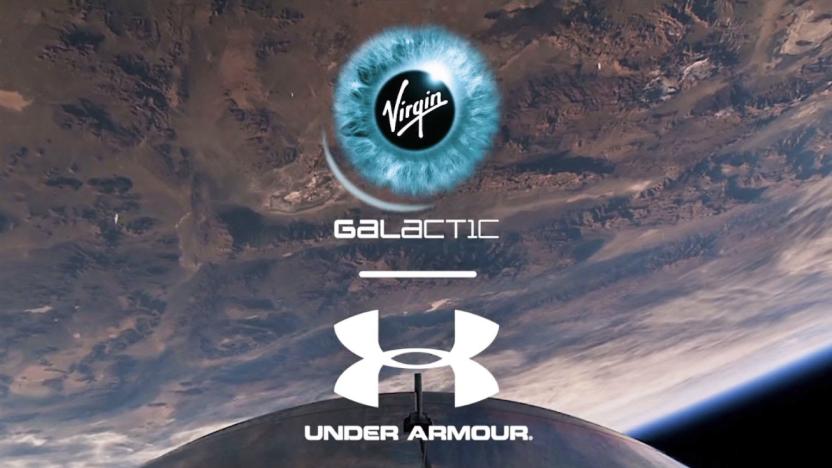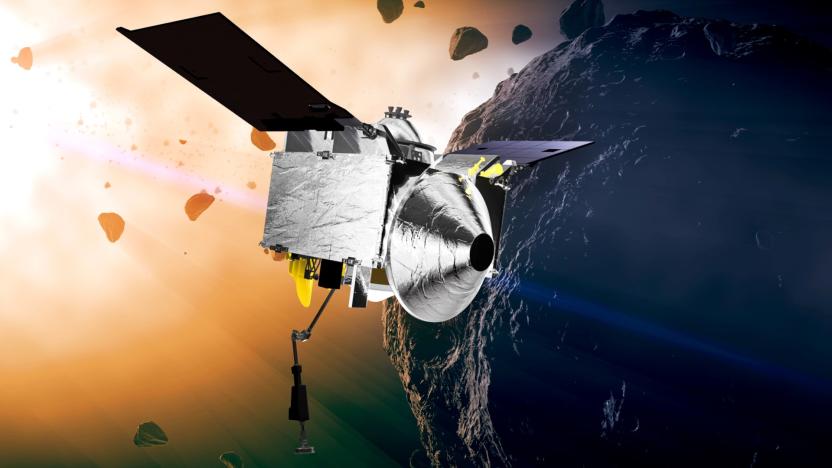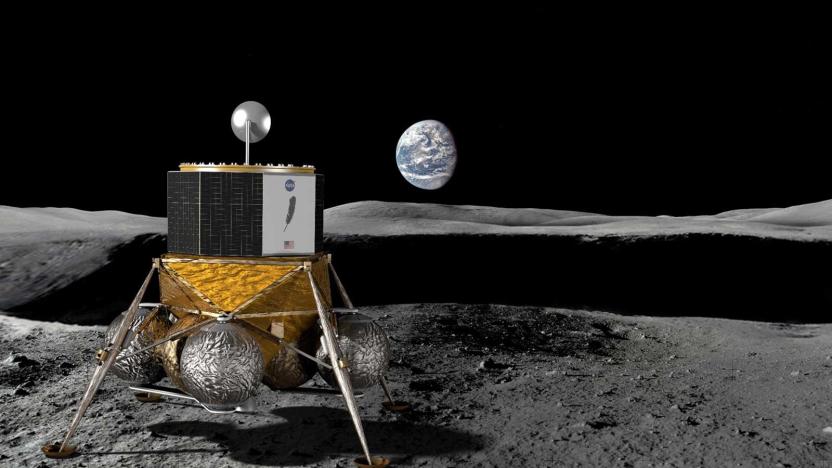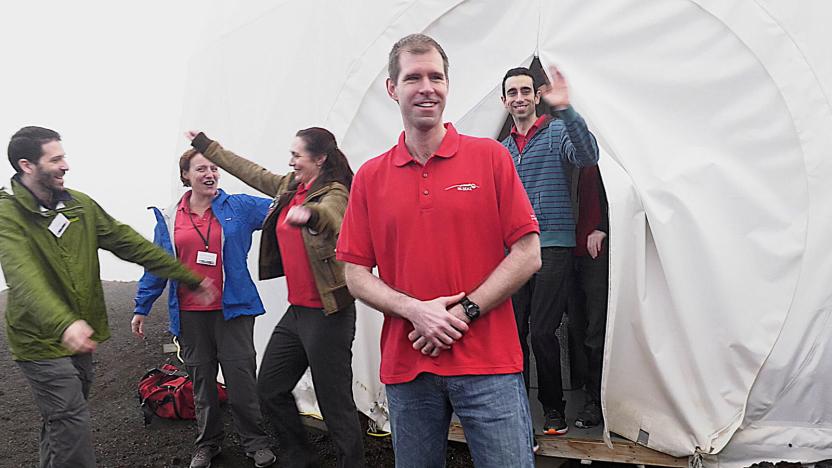SpaceExploration
Latest

Under Armour will make the space suits for Virgin Galactic flights
When Virgin Galactic sends people to space, it plans to send them style. The privacy aerospace company announced today that Under Armour will be designing and producing the space suits and footwear that will be worn by passengers and pilots during future commercial trips to space. The apparel company will also create physical training programs for astronauts to undergo in preparation for the flights.

NASA successfully tests OSIRIS-REx robotic arm ahead of arrival
NASA's spacecraft OSIRIS-REx is just 75 miles from its destination and, just like you would near the end of a light, it's starting to stretch out. The craft successfully tested its Touch-and-Go Sample Acquisition Mechanism (TAGSAM), a robotic arm that will allow it to grab samples from the surface of the asteroid Bennu.

BepiColombo orbiters take off for Mercury tonight
If you've ever wondered what's happening over on Mercury, you'll have an answer soon. Well, soon-ish. BepiColombo, a joint effort between the space agencies of Europe and Japan, will send off a spacecraft Friday night at about 9:45 PM ET with the destination set for the closest rock to the sun. Don't expect to hear much from the little adventurer for a while, though -- it won't reach Mercury's orbit until late 2025.

Lockheed's concept moon lander can carry four astronauts
Lockheed Martin has unveiled the designs for a reusable lander built to ferry four astronauts and 1.1 tons of cargo between lunar orbit and the surface of the moon. Leveraging tech from the aerospace giant's Orion spacecraft for deep-space missions, the 14-meter, single-stage vessel can camp for up to 14 days on the moon. Upon touchdown, the crew will use the craft's lift elevator platform to get from the cabin to the surface, before blasting back to their home base aboard the Lunar Orbital Platform-Gateway -- a small space station that NASA plans to start constructing in 2022.

Jeff Bezos outlines Blue Origin's space colony ambitions
It's no secret that Jeff Bezos wants humanity to return to the Moon and otherwise spread its wings beyond Earth. Now, though, he's offering a clearer sense of what that entails -- and it's evident that his ideas stretch well into the long term. In an interview with GeekWire, he explained that he wants Blue Origin to work with NASA and the ESA to create a permanent settlement on the Moon, but will do whatever it takes to make it happen. Don't expect the company to wait if it thinks officials are wasting time, in other words. The company alreadt anticipates launching its Blue Moon lander (above) by the mid-2020s, but that's contingent on getting enough support.

China starts 200-day simulation of living on another planet
The US definitely doesn't have a monopoly on long-term simulations of living on another planet. Four university students in Beijing have begun a 200-day isolation experiment, Lunar Palace 365 (why not Lunar Palace 200?), where they'll live solely on the resources they would have on the Moon or Mars. That means generating life-giving oxygen from plants, recycling urine to produce drinking water and otherwise making the most of limited supplies.

Trump's transition team asked NASA about mining the moon
President Donald Trump's proposed 2018 budget calls for big cuts to the EPA and Department of Energy, but NASA's budget would only be cut by one percent. It looks like Trump has had designs on NASA that include potential moneymaking activities as well as mining the moon for resources. This comes from documents obtained by Motherboard through a freedom of information act request. According to those documents, Trump's agency review team (ART) asked NASA to "provide data and examples of how NASA does technology development (perhaps even in the form of products) when working with industry -- for example, types of contracts/partnerships and IP arrangements."

Mars hides a gigantic ice sheet that may help astronauts
As a rule, the truly large deposits of ice on Mars are at the poles... right? No. Researchers using the Mars Reconnaissance Orbiter's ground-penetrating radar have discovered that the planet's Utopia Planitia basin is hiding a thick (260 to 560 feet) ice sheet larger than the state of New Mexico. It's at least 50 percent pure, too. Observers had long suspected that the area had water thanks to surface cracking and depressions, but the previous explorer, the Mars Odyssey spacecraft, couldn't study much deeper than the surface.

Simulated Mars mission ends its year-long experiment
A NASA-backed, year-long simulation of living on Mars has finally come to a close. The six people in the HI-SEAS (Hawaii Space Exploration Analog and Simulation) experiment have left their dome on Mauna Loa to rejoin the rest of society. The test shows that a team can maintain performance, resource gathering and social graces while spending long periods in the relative isolation necessary for a Mars mission, whether it's a temporary stay or a full-fledged colony. For example, the crew demonstrated that you can extract water from ground that appears to be dry -- important when astronauts would likely have to ration water carefully.

Japan is planning an unmanned moon mission for 2019
Japan's space program announced today that it wants to become the fourth country to successfully land an unmanned vessel on the moon. The scheduled launch date is planned for 2019 and even though it seems like the world is focused on Mars and beyond right now, Japan wants to show off the latest in lander technology. The craft will use facial recognition software to drastically increase landing accuracy. The on-board technology can scan the surface of the Moon and make slight adjustments to touch down within 100 meters of the target landing site -- that's dramatically better than anything America, China or Russia have launched. Completing this project will help beef up the country's standing in space exploration. With this said, if it has taken this long for Japan to reach the moon, wonder what year they're going to get to Mars?

NASA's bouncing 'Hedgehog' robot is designed to explore comets
The last time humanity tried to explore a comet, things didn't go so well -- the ESA comet lander Philae bounced during touchdown and wound up under a cliff, unable to right itself. Eventually its batteries ran down we lost contact. A sad way to end the mission, but we can't say that we didn't learn anything: NASA engineers are now working on a low-gravity unmanned exploration vehicle designed to bounce, tumble and roll around asteroids and comets. It's called the Hedgehog.

NASA wants more ideas for its low-cost CubeSat nanosatellites
NASA's CubeSat is a (sort-of) adorable tiny satellite that makes space exploration a (relatively) low-cost prospect. Now, the space agency is looking to offer the cube's talents and exploration skills to even more NASA centers, educational institutions and non-profit organizations. Developers will get be able to conduct research that's "consistent with NASA's strategic plan". CubeSats will be launched by February of 2016, but being selected doesn't necessarily mean that project will launch.

NASA's New Horizons captures images of mysterious spots on Pluto
As the New Horizons spacecraft preps for its inspection of Pluto on July 14th, NASA provided a status update with some interesting info. First, new color images show a series of spots along the dwarf planet's equator. The evenly-spaced spots are about 300 miles (480 kilometers) in diameter, or about the size of the state of Missouri. Due to the spacing and size, scientists are unable to determine their origin for the time being, but that could change as New Horizons moves in for a closer look. Another thing researchers will be looking for as the spacecraft makes its approach? Clouds. Should Pluto have them, they can be used to track the speed and direction of the planet's winds.

Japanese company plans to have working space elevator by 2050
Who does want to go to space? No less, in an elevator. While NASA's been working hard for years trying to find the necessary tools to do just that, other firms are doing the same across different parts of the world. Japanese construction company Obayashi, for instance, is one of those, and today it revealed its plans to have a fully functional space elevator by the year 2050. As Australian Broadcasting Corporation reports, Obayashi says it is working to build a space elevator that can reach 96,000 kilometers (roughly 60,000 miles) into space, capable of transporting people and cargo at a much lower cost than the rockets traditionally launched from Earth. The trip on Obayashi's space elevator is said to take a total of seven days one-way, with the destination being a space station that would be built specifically for this scenario.

NASA successfully tests microwave thruster, paving the way for speedier space travel
As with airplanes and many other self-powered machines, the fuel a shuttle engine requires can weigh nearly as much as the object it's propelling, increasing costs while significantly limiting range. It's a challenge we're going to need to overcome before launching long-distance treks through space, where carrying enough fuel may not currently be possible. One proposed method for getting future spacecrafts to their destinations is by utilizing a device called a microwave thruster. A British scientist named Roger Shawyer managed to build a similar engine called an EmDrive several years ago, and while a Chinese team also accomplished the same, the rest of the world hasn't paid much attention until NASA confirmed from its own research that such a device could work during a presentation earlier this week.

Civilization: Beyond Earth ships October 24th with maps based on real planets
If you're eager to play the first Civilization game set in space (not counting Alpha Centauri), you now have a date to mark on your calendar: Beyond Earth will reach Windows-based PCs on October 24th. That's a long time to wait, although Firaxis is sweetening the pot with astronomy-themed bonus content. If you pre-order the space colonization game from certain stores, you'll get a map pack based loosely on real, potentially inhabitable exoplanets like Kepler 186f and Rigil Khantoris (aka Rigel Kentaurus) Bb. It's hard to say if the extra terrain will be worth plunking down cash in advance, but we suspect that you've already pulled the trigger if you're a die-hard Civ fan -- this is just icing on the extraterrestrial cake.

NASA wants to put your name on a spacecraft headed to an asteroid
Forget those dime-a-dozen "name a star" gifts -- wouldn't you rather put your name on a spacecraft that advances human understanding? NASA certainly thinks you do. It's teaming up with the Planetary Society to etch your name on chips inside its OSIRIS-REx probe, which will head toward the asteroid Bennu in 2016. While it's doubtful that any aliens will read your microscopic claim to fame, it'll certainly get the grand tour. The spacecraft will spend 500 days around the asteroid before heading back, and both the decommissioned vehicle as well as the returning sample capsule will have your ID. You can register your name today for free; just be prepared to wait years for the payoff.

NASA halts efforts to repair Kepler space telescope
It's had a good run, but it seems like NASA's Kepler telescope is down for the count -- the space agency says it has stopped repair efforts. The 0.95 meter diameter space telescope launched four years ago, tasked with seeking out Earth-sized planets suitable for habitation. All was going well until the rig's gyroscopic reaction wheels began to fail, robbing it of the precision aim needed to continue its task. After months of testing, NASA has concluded that it won't be able to restore the telescope to full working order. That doesn't mean the mission is at an end, however -- NASA still has to sort troves of previously collected data, thumbing through over 3,500 exoplanet candidates to add to the 135 celestial bodies Kepler has already identified. The hardware may one day see a second life too, as engineers attempt to assess what can be done with the remaining two reaction wheels and the telescope's attitude control thrusters. Without significant (and now abandoned) repair efforts, Kepler will never be precise enough to continue its primary mission, but NASA is hopeful it will eventually find a new purpose.

NASA picks eight astronaut trainees that may go to asteroids and Mars (video)
If you like space exploration, you'll want to get used to these eight faces -- odds are that you'll see at least some of them again. They represent NASA's 2013 astronaut candidate class, and they'll start training in August for a chance at going on missions to the International Space Station, asteroids and even Mars. The trainee pool is more eclectic than usual this time around. Half the picks are women, while three of the candidates come from non-military outfits such as Harvard Medical School and NOAA. Check out the full roster after the break.

Visualized: Space hurricane! NASA's Cassini records super cyclone on Saturn (video)
If the crashing sound of lightning striking Saturn wasn't enough to excite your inner-meteorologist, then perhaps footage of a raging extraterrestrial hurricane will win you over. After orbiting the ringed planet for nine years, NASA's Cassini probe has managed to snag video of a super storm on the celestial body's north pole. Cloaked by the darkness of winter, the hurricane's eye became visible as Saturn's northern hemisphere transitioned into spring. Unlike the tropical cyclones of Earth (see: Hurricane Katrina, Sandy and Irene), this furious typhoon has been spinning for several years and has winds that flow at speeds exceeding 300MPH. Further differentiating itself from our world's whirlwinds, this alien cyclone is locked to its planet's north pole and is fueled by small amounts of water vapor instead of an actual ocean. Completely in a category of its own, the hurricane's eye measures about 1,250 miles wide and is surrounded by fluffy white clouds the size of Texas. To see this Saturnian fury in all its glory, check out the video after the break and feel free to leave your gratuitous hurricane names in the comments below.










